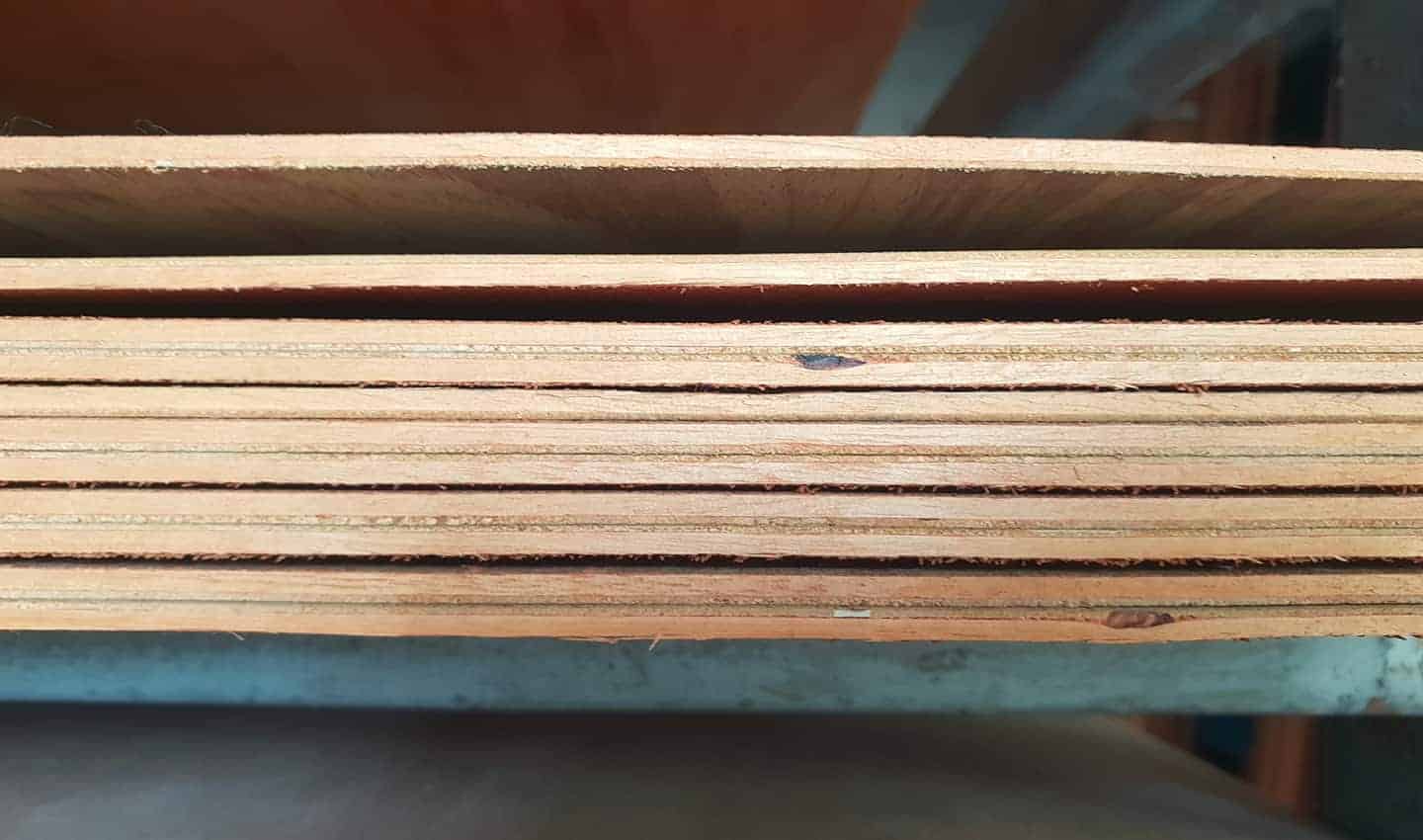Marine Grade Plywood: Everything You Need to Know

When it comes to marine construction, regular plywood just won’t make the cut. If you want to attain the level of form and finish that can withstand unrelenting water exposure, then we’ve got three words for you – Marine Grade Plywood.
What is Marine Grade Plywood
Marine Grade Plywood is specifically designed to offer high resistance to water and helps prevent fungus, dampness, and rot.
The classification “Marine Grade” means that the plywood meets the highest standards required by the APA (The Engineered Wood Association). It’s the only grade of plywood approved for constant water immersion over long periods of time.
Due to its sturdier and higher quality build, Marine Plywood is usually intended for hull construction, but it can also be used for interior structures to help fight against moisture and humidity. It’s compatible with almost all types of marine construction – from the smallest kayaks to the largest yachts.
Marine Grade Plywood is constructed from types of hardwood species that have enough durability to survive in a marine-type environment, the most common being Western Larch or Douglas Fir. They are characterized by having a natural resistance to both heat and pressure, so that the wood can take on the glue effectively.
Marine Grade Plywood is classified into different grades based on their external appearance, with A being the highest quality and B being the lowest. Both B-grade and A-grade plywood is always sanded and treated for water resistance. But A-grade veneer is more prized for its smoother finish because of the lack of both knots and knotholes – those circular imperfections that are visible on the surface of wood.
Features of Marine Grade Plywood: What Makes it Special?
Over the years, marine grade plywood has been regarded as prized boat-building material – and for good reasons.
It has a Lawyered and Laminated Exterior
To give the plywood an extra level of durability, the thin sheets of veneer are stacked perpendicularly on top layer by layer. This is a process called “cross lamination” and this is what gives the plywood its unusually strong build. It keeps the panel sturdy at both ends for easier and sturdier construction.
It is Treated with Waterproof Glue
Contrary to popular belief – the wood used Marine Grade Plywood is not waterproof.
What gives it that waterproof quality is the glue treatment process. The layers of wood are bonded with heat and pressure using a water-resistant structural adhesive – usually clear epoxy or resorcinol-type glues. When dried, it creates a strong finish that fights against the harsh effects of constant exposure to moisture, unpredictable temperatures, and high humidity.
This is particularly true when it comes to the boat’s hull. Because the hull takes on the most pressure, the glue finish ensures that the plywood stays structurally intact and the laminated veneers won’t divide into smaller layers.
The Surface of the Wood is Entirely Poreless
Part of the process of treating Marine Plywood is sanding and laminating the outermost layers. This procedure, combined with cross lamination, ensures that both ends of the panel are free from holes and air pockets — so that there’s no chance of water seeping through the crevices in between the layers.
Marine Grade Plywood vs Regular Plywood
Marine Plywood is often ignored by amateur boat builders because of the higher cost. The benefits of using marine plywood over regular plywood far outweighs the extra costs.
Marine Plywood is Stronger and More Durable than Regular Plywood
Marine Plywood, by itself, already has an inherent advantage: it’s made of hardwood varieties that are thick and dense.
Stacked together, they form a thick panel with finer grains that can block any amount of moisture and water impact. Using it in the construction of boat parts ensures that the structure stays intact even in the harshest of weathers and are guaranteed to be able to carry a heavier internal load.
Regular plywood, on the other hand, is typically made of softwood like pine. While this type of wood may be used in other home construction projects, it is definitely more susceptible to water infiltration and decay because of its naturally larger wood grains – making it unsuitable for marine applications.
Marine Plywood Has a Smoother Exterior Than Regular Plywood
Even at first glance, it’s easy to see the difference between the two types of plywood.
The exterior surface of Marine Plywood is baby smooth and shiny, giving it a more aesthetically pleasing look. This is due in part to the lamination process and the final layer of waterproof glue placed on the outermost veneers.
More than just pleasing to the eye, its smooth finish also creates an extra barrier to handle any amount of moisture – so that instead of seeping through the wood, the water simply slides away. It’s also much easier to paint, since the wood expands and contracts but doesn’t break the paint.
Regular plywood, on the other hand, has a rough exterior surface due to the chemical treatment and lack of a laminated finish.
Marine Plywood Has More Layers Than Regular Plywood
Marine Plywood has at least five layers of premium quality hardwood that are bound together to form one sturdy panel. As a result, it doesn’t have as many voids as regular plywood and it’s cleaner to cut and shape – making it 10 times structurally stronger.
Regular plywood, on the other hand, has only three layers – clearly lacking the density required for any marine environment. In effect, it has a thinner panel that is scattered with voids – holes in the surface that act like mini air pockets. These voids are especially visible when cutting through the corners of the wood.
Marine Grade Plywood Lasts Longer Than Regular Plywood
Typically, Marine Plywood lasts up to 25 years – depending on its maintenance and marine conditions. The longer life expectancy is due to sturdier layers that effectively make it scratch proof and impact resistant. Its extreme resistance to high temperatures also keeps it generally safe from the normal wear-and-tear damage that most marine vessels accumulate through the years.
Regular plywood, on the other hand, degrades faster even after short periods of time – making it extremely unreliable for long term use.
Marine Plywood has Higher Quality Standards Than Regular Plywood
Marine Plywood has only two grades: A and B. Both grades meet the highest standards of quality required for marine operation. This higher rating means that the plywood has lesser knots and other visible defects.
Regular plywood, on the other hand, is classified with grades that go as low as D-grade. More than just visibly more defective, the rating also relates to the panel’s overall quality in terms of structure and durability. This sub-par rating fails to meet the required quality grade for marine construction.
Marine Plywood is More Resistant to Decay and Rot Than Regular Plywood
Marine Plywood does not receive any kind of chemical treatment – it is instead pressure treated using a combination of cross lamination and glue bonding. The lack of hazardous chemicals retains the smooth finish of the plywood and preserves the wood’s natural resistance to moisture – preventing the onset of decay and degradation.
Regular plywood, on the other hand, goes through several chemical treatment processes that are intended to help it last longer, but decreases its natural water and heat resistance. Some of the chemicals used are copper and arsenic which also tend to poison marine life when submerged in water for long periods of time.
Marine Grade Plywood is more Flexible than Regular Plywood
Despite its sturdy and dense build, Marine Plywood is in fact lightweight and extremely pliable.
This means that it’s easy to cut and bend into different angles while still maintaining its shape and structural integrity. Its flexible nature also keeps it scratch proof and ensures that it doesn’t crack or deform when caught in adverse marine conditions. This quality also makes it a good choice for any DIY boat builder, because you can carry it around with ease and without having to worry about dents on the edges when dropping them.
Regular plywood, on the other hand, has a more stiff construction – making it not only more difficult to cut and bend, but also makes it a lot heavier to transport.
Why You Should Use Marine Grade Plywood
When it comes to boat building, everything boils down to three important factors: strength, durability and water resistance – and Marine Grade Plywood definitely meets all these requirements.
With its natural resistance against impact and decay, Marine Plywood is the key to helping you and your boat sail through the harshest marine conditions. Its durability and structural integrity will give you the confidence that it will last for years without too much maintenance.
More than just practicality, Marine Plywood will also offer you a lot of design and structural options. Its pliable quality makes it easier to form while its poreless surface sticks to paint well – giving you a smooth and elegant finish that regular plywood just can’t deliver.
This article may contain affiliate links which I earn a commision through when you purchase. As an Amazon Associate I earn from qualifying purchases.
Please read why I do this and my commitment to accurate and compelling content.


